Bayonet 6X4
In the mid-sixties, an attempt was made to modernize the bayonet 6X3 with the experience of its operation. It was supposed to improve the ergonomics of weapons, as well as improve some other characteristics. The result of such proposals was the emergence of a new handle and a modernized scabbard. It is noteworthy that during the modernization, the shape of the blade itself did not change. This part of the bayonet completely satisfied the customer, due to which its updating was not required. The upgraded bayonet for AKM and SVD rifles received the symbol 6X4.
The 6XX3 bayonet was based on the design of a knife for naval intelligence officers, developed by R.M. Todorov in the mid-fifties. This knife was different from other samples by the characteristic shape of the blade and the additional device with which the knife was turned into nippers. The design of the blade "sea" knife interested gunsmiths from the team of M.T. Kalashnikov, the result of which was the emergence of a new original bayonet of unusual shape.
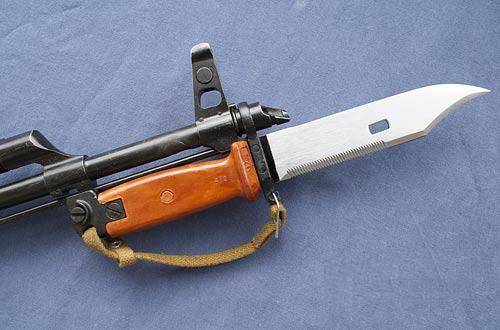
The bayonet 6X4 on the AKM machine. Photo Sharpknife.ru
Operation confirmed the high characteristics of this blade, so that it became possible not to change it when upgrading the bayonet. The bayonet 6X4, like its predecessor, received a blade with a double-edged fighting end with a bevel on the butt and a sharpening on one of the faces. On the second side of the blade there was a notch in the form of small teeth. In the middle part of the blade there was a rectangular hole for attaching to the sheath when using the bayonet as nippers. The blade length was 150 mm, width - 30 mm.
Significant improvements undergone the handle of the bayonet. The basic design of the 6X3 had some drawbacks, due to which the updated handle was used in the new project. In its front part there was a cross with attachments for mounting on a weapon and a hook for the strap. From the side of the main blade on the cross, there was a ring with an inner diameter of 17,7 mm, designed to be mounted on the barrel of the weapon. On the other side of the cross was a small hook for the strap.
The head of the handle was again made in the form of a metal block consisting of two halves, with a cavity accommodating the fastening mechanisms. From the butt of the blade in this block there was a through hole for the strap, from the side of the blade - a groove in the form of an inverted "T". In the internal cavity of the head there was a spring-loaded latch for fixing on the machine. The latch is controlled by a button on the right side of the bayonet (in the fighting position). Pressing the button released the latch. According to the operating experience of some of the previous bayonets, the button was covered with a small shoulder, which excluded accidental pressing and an abnormal disruption of the bayonet from the mounts.
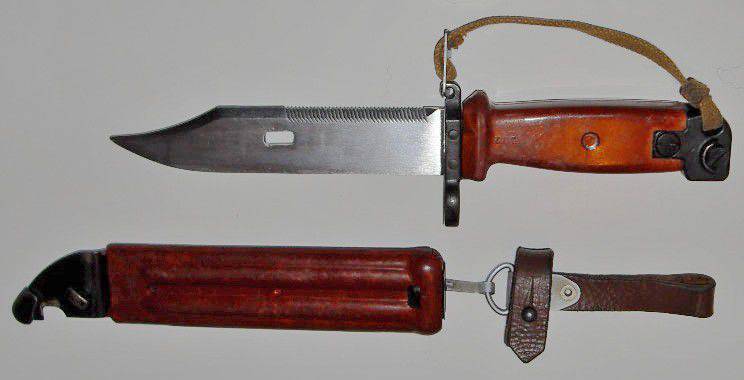
Bayonet and its scabbard. The loop and the scabbard strap are visible. Photo of Wikimedia Commons
Between the cross and the head on the shank of the blade was fixed plastic lining, made in the form of one piece. To simplify the design, the cover was fixed with just one rivet. The pad had a comfortable ergonomic shape. On the side of the blade and the mount it had a shallow groove. In the combat position in this groove should have entered the automatic ramrod.
Despite a lot of changes, the new bayonet 6X4 was almost the same as the previous 6X3 in terms of size and weight. The total length of this weapon was 270 mm, the mass was of the order of 250. Thus, the changes had no effect on the balance of the machine gun with the bayonet and other features of the use of blades.
The bayonet of the new model was proposed to be equipped with modernized sheaths that have significant differences from the base ones. As before, the blade was proposed to be placed in a rectangular oblong metal part. At the bottom of the scabbard preserved detail of complex shape with a T-shaped attachment for the bayonet and the notch used for cutting the wire. A plastic lining with longitudinal protrusions covering the entire main part of the sheath has become a characteristic feature of the new scabbard. Among other things, it allowed to reduce the risks when cutting wire under current.
On one side of the scabbard lining, a metal axis was provided for attaching the suspension system. The latter consisted of a carbine with a loop and two leather parts. With the help of a loop, the sheath was suggested to be hung on a belt, and the perpendicular strip with a fastener made it possible to fix the bayonet and did not allow it to spontaneously leave the sheath.
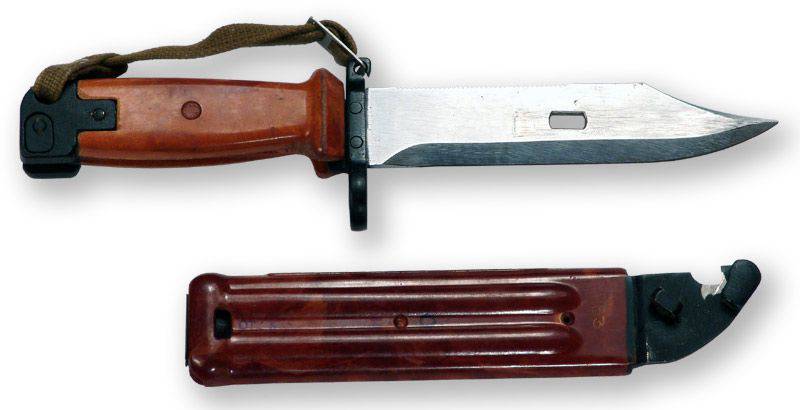
Bayonet and sheath on the other side. Photo Rusknife.com
The installation of the bayonet knife 6X4 on an AKM machine gun or other compatible weapon was made as follows. The bayonet should have been placed under the barrel with the blade up. After that, the ring of the crosspiece was required to be put on the muzzle of the barrel, at the same time pulling the groove of the handle head on the corresponding influx under the barrel. When the bayonet was moved back, the ring was placed on the muzzle, and the barrel's influx entered the groove and was fixed with a latch. In the combat position, the main blade of the blade was located at the top and allowed to apply piercing and cutting blows. To remove the bayonet, you had to press a button on the handle's head and pull it forward.
Depending on the need, the bayonet could solve several problems. Before the battle with possible melee fights should be installed on his weapon. In other situations, the bayonet had to remain in the sheath and, if necessary, be used as a cutting tool. With it, you can cut a variety of materials, including wood and metal. For cutting, it was possible to use both the main blade and the serrer on the butt. Wire, including barriers under tension, should be cut with a sheath. For this, the blade with its hole was attached to the corresponding protrusion of the sheath, which made it possible to cut the wire without the risk of electrical injury.
According to various sources, the bayonets of the type 6X4 went into series at the beginning of the second half of the sixties. AKM's new series of machines were equipped with modernized bayonets, and the existing weapons did not receive new blades. Special rearmament was not made, because of which for some time the arrows of the Soviet army in parallel used bayone-knives of two models. In the future, it was planned to gradually decommission automata of the old series with bayonets. Thus, 6X4 could gradually completely replace the existing 6X3.
The production of bayonets was carried out in Tula and Izhevsk. The products of the two enterprises did not have noticeable differences from each other and, in fact, differed only in marking. The stamp of the plant was placed on the handle of the bayonet and on the plastic lining of the sheath. In addition, technical control stamps were put on metal parts. Product numbers were engraved on plastic parts. Also on the plastic there could be OTC stamps made in ink. In view of the duration of the release, bayonet knives of various series could noticeably differ from each other in the composition and arrangement of different marks, stamps, etc.
It is known about the existence of a so-called. lightweight modification of the bayonet 6X4, differing design of several parts. The most notable difference of such a bayonet was the head of a handle of a different shape. Now it did not consist of two halves, but was made in the form of one piece. In addition, its shape has changed from the butt of the blade. Instead of a wide block with a through hole, there was now a recess with a protruding loop for the strap. The fasteners and the latch remained the same.
The lightweight version of the bayonet differed from the basic design by a slightly lower weight, but it was much more difficult from the point of view of production. Such a ratio of pros and cons affected the future of the development. The mass gain was completely leveled by technological complexity, which is why the production of lightweight bayonets did not last long, and the number of manufactured products of this type was significantly inferior to the number of basic 6X4.
The bayonet knives 6X4 were produced in the Soviet Union, and their main operator was the domestic armed forces. Over time, these products began to be exported. In addition, a number of foreign countries have established the production of their own bayonets. In most cases, foreign enterprises produced exact copies of Soviet 6X4, however in some countries the bayonets changed.
So, there is information about the production in China of special bayonets for foreign customers. In general, such a bayonet repeated the design of the 6X4, however, it did not have a hole in the blade, and the sheath was not equipped with pliers elements and was completely made of plastic. Mounts for mounting on the machine and the belt system for hanging the sheath on the belt remained the same. As far as we know, such bayonets were not supplied to the Chinese army and were issued only on the order of third countries.
Polish and Egyptian enterprises also did not begin to master the production of the original sheath from 6X4, having adjusted the production of simpler sheaths from 6XXNNUMX. In addition, the Polish bayonet knives 3X6 were distinguished by the absence of a serreytor, and the characteristic feature of Egyptian products was the low quality of production: in particular, there were large gaps between the parts, which for durability and reliability were filled with glue.
The bayonet 6X4 was originally developed for use with an AKM assault rifle, which was the main small arms of the Soviet army in the mid-sixties. Compatibility of fasteners allowed equipping SVD sniper rifles with such bayonets, but in this case the blades were not intended for bayonet combat. For some time, machine guns and rifles were operated with two types of bayonets.
In the late seventies, a new family of small arms designed by M.T. Kalashnikov, including automatic AK-74. Despite a lot of serious innovations, these weapons initially had to be fully compatible with existing bayonets. For this reason, the new bayonet for AK-74 was not developed. With the new machine it was proposed to use the existing product 6X4, the release of which continued. In addition, due to the similarity of structures, the use of 6X3 was not excluded, but such a bayonet was not standard.
The bayonets of the 6X4 type were issued until the end of the eighties. For two decades of production, several hundreds of thousands of blades were manufactured that were used to assemble several types of small arms. Initially, AKM and SVD rifles were equipped with such cold arms, and later it was used together with AK-74. At the very end of the eighties, the new bayonet 6X5, designed for AK-74 machines, was developed and put into series. In this regard, the production of the old 6X4 was discontinued.
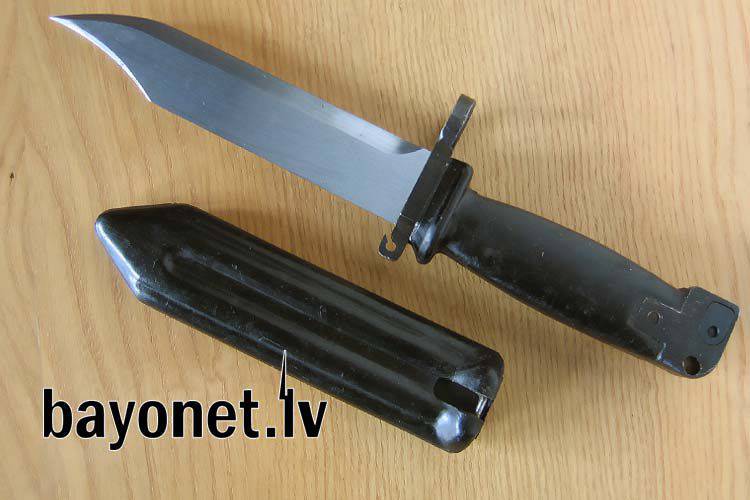
Export bayonet made in China with a simplified blade and scabbard. Photo Bayonet.lv
Despite the creation of new modifications of small arms, AK-74 assault rifles, including their upgraded version of AK-74M, are still the main small arms of the Russian armed forces. Together with these assault rifles, the 6XXNNXX bayonets, created in the mid-sixties, remain in service. Despite their considerable age, such bayonets are still an important element of equipping a soldier and are unlikely to come out of circulation in the foreseeable future. Apparently, such bayonets will be taken out of service only with their “native” machine guns, which are used en masse and still remain in the army.
Almost 60 years ago, during the project of the bayonet 6X3, it was possible to develop a very successful sample of a multifunctional cutting tool designed to solve a number of different tasks. This cold weapon satisfied the customer and showed his full potential, thanks to which further modernization could be carried out without changing the blade design. All improvements used in the project 6X4, were aimed only at improving ergonomics and improving the "auxiliary" characteristics. In particular, a more comfortable long plastic lining of the sheath and some other details of a different shape appeared.
All these improvements have made it possible to make a good weapon even more convenient. The result of such improvements was a very long and long career bayonet. Soon half a century has passed since the start of mass production and operation of 6X4 products. It can be assumed that such bayonets will remain in service over the next few years. Thus, in terms of the duration of their exploitation, the 6X4 bayonets can only be compared with the needle blades of Mosin rifles, which have also been used for more than half a century. This can serve as one of the main evidence of the success of the structure.
On the materials of the sites:
http://bayonet.lv/
http://bratishka.ru/
http://rusknife.com/
http://ak-info.ru/
http://zonwar.ru/
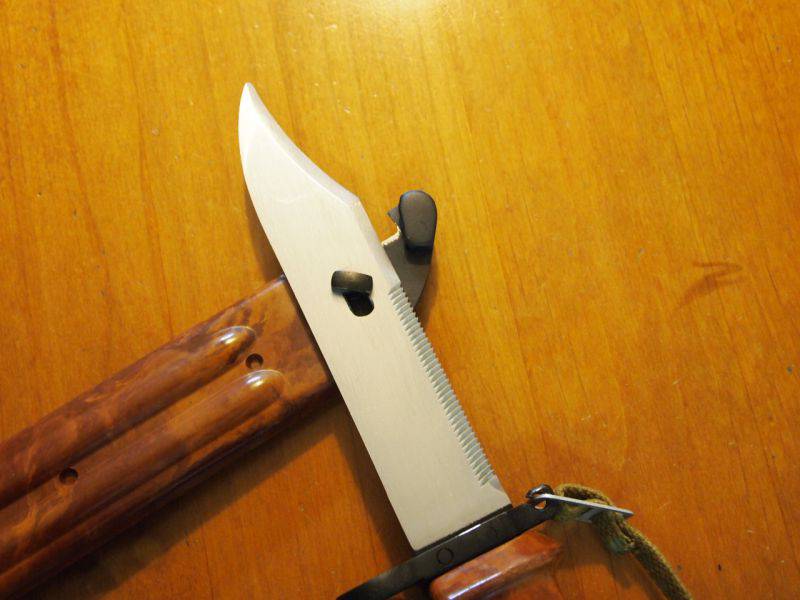
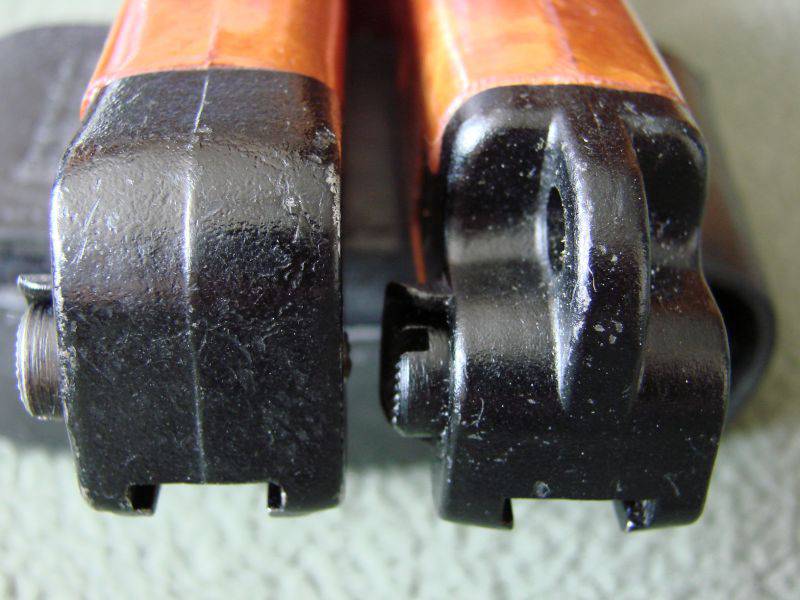
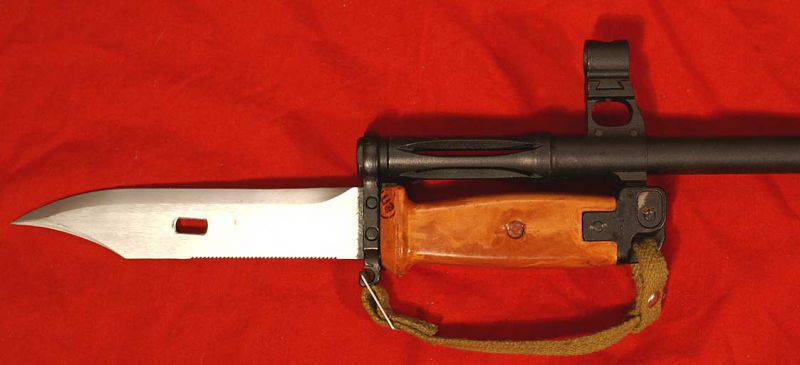
Information